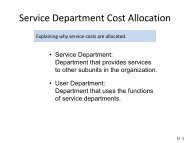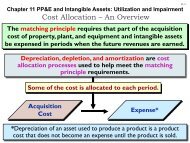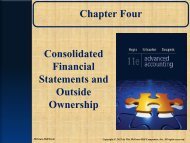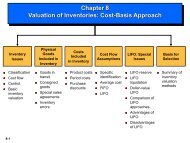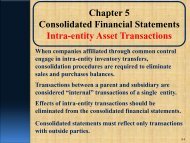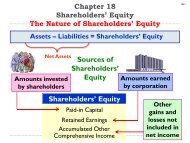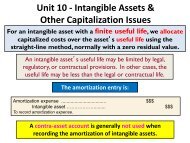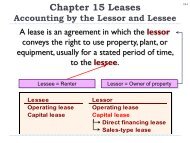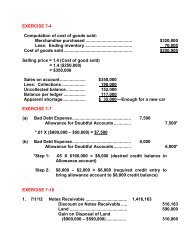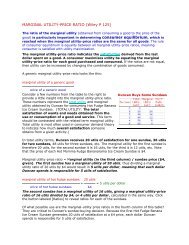Service Department Cost Allocation - Anna Lee
Service Department Cost Allocation - Anna Lee
Service Department Cost Allocation - Anna Lee
You also want an ePaper? Increase the reach of your titles
YUMPU automatically turns print PDFs into web optimized ePapers that Google loves.
<strong>Service</strong> <strong>Department</strong> <strong>Cost</strong> <strong>Allocation</strong><br />
Explaining why service costs are allocated.<br />
• <strong>Service</strong> <strong>Department</strong>:<br />
<strong>Department</strong> that provides services<br />
to other subunits in the organization.<br />
• User <strong>Department</strong>:<br />
<strong>Department</strong> that uses the functions<br />
of service departments.<br />
11 - 1
LO1<br />
<strong>Service</strong> <strong>Department</strong> <strong>Cost</strong> <strong>Allocation</strong><br />
• Intermediate cost center:<br />
<strong>Cost</strong> center whose costs are charged<br />
to other departments in the organization.<br />
• Final cost center:<br />
<strong>Cost</strong> center, such as a production or<br />
marketing department, whose costs<br />
are not allocated to another cost center.<br />
11 - 2
LO1<br />
<strong>Service</strong> <strong>Department</strong> <strong>Cost</strong> <strong>Allocation</strong><br />
<strong>Service</strong> and User <strong>Department</strong>s – Carlyle Coal Company<br />
<strong>Service</strong> <strong>Department</strong>:<br />
Information Systems<br />
(S1)<br />
<strong>Service</strong> <strong>Department</strong>:<br />
Administration<br />
(S2)<br />
User <strong>Department</strong>:<br />
Hilltop Mine<br />
(P1)<br />
User <strong>Department</strong>:<br />
Pacific Mine<br />
(P2)<br />
11 - 3
LO1<br />
<strong>Service</strong> <strong>Department</strong> <strong>Cost</strong> <strong>Allocation</strong><br />
Basic Data for <strong>Service</strong> <strong>Department</strong> <strong>Cost</strong> Association<br />
Carlyle Coal Company<br />
Information<br />
Systems (S1) a<br />
<strong>Service</strong> <strong>Department</strong><br />
Administration<br />
(S2) b<br />
<strong>Department</strong>s:<br />
Administration (S2)<br />
Information Systems (S1)<br />
Hilltop Mine (P1)<br />
Pacific Mine (P2)<br />
Total (to be distributed)<br />
hours<br />
100,000<br />
-0-<br />
20,000<br />
80,000<br />
200,000<br />
50%<br />
0<br />
10<br />
40<br />
100%<br />
employees)<br />
-0-<br />
2,000<br />
5,000<br />
3,000<br />
10,000<br />
0%<br />
20<br />
50<br />
30<br />
100%<br />
a<br />
<strong>Allocation</strong> base for S1: Computer hours; <strong>Cost</strong> to be allocated: $800,000<br />
b<br />
<strong>Allocation</strong> base for S2: Number of employees; <strong>Cost</strong> to be allocated: $5,000,000<br />
11 - 4
<strong>Cost</strong> <strong>Allocation</strong>: Direct Method<br />
• Direct method:<br />
Charges costs of service departments to user departments<br />
without making allocations among service departments.<br />
<strong>Service</strong> <strong>Department</strong>:<br />
Information Systems<br />
(S1)<br />
<strong>Service</strong> <strong>Department</strong>:<br />
Administration<br />
(S2)<br />
User <strong>Department</strong>:<br />
Hilltop Mine<br />
(P1)<br />
User <strong>Department</strong>:<br />
Pacific Mine<br />
(P2)<br />
11 - 5
LO2<br />
<strong>Cost</strong> <strong>Allocation</strong>: Direct Method<br />
<strong>Service</strong> <strong>Department</strong><br />
<strong>Cost</strong> <strong>Allocation</strong><br />
Direct<br />
<strong>Cost</strong><br />
Hilltop Mine<br />
(P1)<br />
Percent Applicable to<br />
Pacific Mine<br />
(P2)<br />
Total<br />
<strong>Service</strong> <strong>Department</strong>:<br />
Information Systems (S1)<br />
Administration (S2)<br />
<strong>Service</strong> <strong>Department</strong>:<br />
Information Systems (S1)<br />
Administration (S2)<br />
Total allocated<br />
$ 800,000<br />
5,000,000<br />
Direct<br />
<strong>Cost</strong><br />
$ 800,000<br />
5,000,000<br />
$5,800,000<br />
Note: Under this method, S1 costs doesn’t allocate to S2.<br />
20.0% a<br />
62.5% b<br />
Hilltop Mine<br />
(P1)<br />
$ 160,000 c<br />
3,125,000 d<br />
$3,285,000<br />
a<br />
20.0% = 20,000 hours ÷ (20,000 hours + 80,000 hours)<br />
b<br />
62.5% = 5,000 employees ÷ (5,000 employees + 3,000 employees)<br />
c<br />
$160,000 = 20% × $800,000<br />
d<br />
$3,125,000 = 62.5% × $5,000,000<br />
80.0%<br />
37.5%<br />
Amount Applicable to<br />
Pacific Mine<br />
(P2)<br />
$ 640,000<br />
1,875,000<br />
$2,515,000<br />
100.0%<br />
100.0%<br />
Total<br />
$ 800,000<br />
5,000,000<br />
$5,800,000<br />
11 - 6
<strong>Cost</strong> <strong>Allocation</strong>: Step Method<br />
• The step method allocates some service<br />
department costs to other service departments.<br />
• Once an allocation is made from a service<br />
department no further allocations are made<br />
back to that service department.<br />
• Generally, allocate in order of proportion of<br />
services provided to other service departments.<br />
11 - 7
LO3<br />
<strong>Cost</strong> <strong>Allocation</strong>: Step Method<br />
<strong>Cost</strong> Flow Diagram: Step Method – Carlyle Coal Company<br />
<strong>Service</strong> <strong>Department</strong>:<br />
Information Systems<br />
(S1)<br />
Computerhours<br />
User <strong>Department</strong>:<br />
Hilltop Mine<br />
(P1)<br />
<strong>Service</strong> <strong>Department</strong>:<br />
Administration<br />
(S2)<br />
Employees<br />
User <strong>Department</strong>:<br />
Pacific Mine<br />
(P2)<br />
11 - 8
LO3<br />
<strong>Cost</strong> <strong>Allocation</strong>: Step Method<br />
<strong>Service</strong> <strong>Department</strong> <strong>Cost</strong> <strong>Allocation</strong><br />
Direct<br />
<strong>Cost</strong><br />
(S1)<br />
Percent Applicable to<br />
(S2)<br />
(P1)<br />
(P2)<br />
Total<br />
<strong>Service</strong> Dept.:<br />
(S1)<br />
(S2)<br />
$ 800,000<br />
5,000,000<br />
0.0%<br />
0.0%<br />
50.0% a<br />
0.0%<br />
10.0% b<br />
62.5% d<br />
40.0% c<br />
37.5% e<br />
100.0%<br />
100.0%<br />
a<br />
50.0% = 100,000 hours ÷ (100,000 hours + 20,000 hours + 80,000 hours)<br />
b<br />
10.0% = 20,000 hours ÷ (100,000 hours + 20,000 hours + 80,000 hours)<br />
c<br />
40.0% = 80,000 hours ÷ (100,000 hours + 20,000 hours + 80,000 hours<br />
d<br />
62.5% = 5,000 employees ÷ (5,000 employees + 3,000 employees)<br />
e<br />
37.5% = 3,000 employees ÷ (5,000 employees + 3,000 employees)<br />
11 - 9
LO3<br />
<strong>Cost</strong> <strong>Allocation</strong>: Step Method<br />
<strong>Service</strong> <strong>Department</strong> <strong>Cost</strong> <strong>Allocation</strong><br />
To<br />
From<br />
(S1)<br />
(S2)<br />
(P1)<br />
(P2)<br />
Total<br />
Dept. costs<br />
(S1)<br />
(S2)<br />
$800,000<br />
(800,000)<br />
-0-<br />
$ -0-<br />
$5,000,000<br />
400,000 f<br />
(5,400,000)<br />
$ -0-<br />
Note: Under Step method, S1 costs does allocate to S2<br />
.<br />
f<br />
50.0% × $800,000<br />
g<br />
10.0% × $800,000<br />
h<br />
40.0% × $800,000<br />
I<br />
62.5% × $5,400,000<br />
j<br />
37.5% × $5,400,000<br />
k<br />
$5,800,000 of service department costs were<br />
ultimately allocated to production departments.<br />
$ -0-<br />
80,000 g<br />
3,375,000 i<br />
$3,455,000<br />
$ -0-<br />
320,000 h<br />
2,025,000 j<br />
$2,345,000<br />
$5,800,000 k<br />
$5,800,000 k<br />
11 - 10
<strong>Cost</strong> <strong>Allocation</strong>: Reciprocal Method<br />
• The reciprocal method recognizes all services<br />
provided by any service department, including<br />
services provided to other service departments.<br />
• It accounts for cost flows among service<br />
departments providing services to each other.<br />
• It requires a simultaneous equation solution.<br />
11 - 11
LO4<br />
<strong>Cost</strong> <strong>Allocation</strong>: Reciprocal Method<br />
<strong>Cost</strong> Flow Diagram: Reciprocal Method – Carlyle Coal Company<br />
<strong>Service</strong> <strong>Department</strong>:<br />
Information Systems<br />
(S1)<br />
Computerhours<br />
User <strong>Department</strong>:<br />
Hilltop Mine<br />
(P1)<br />
<strong>Service</strong> <strong>Department</strong>:<br />
Administration<br />
(S2)<br />
Employees<br />
User <strong>Department</strong>:<br />
Pacific Mine<br />
(P2)<br />
11 - 12
LO4<br />
<strong>Cost</strong> <strong>Allocation</strong>: Reciprocal Method<br />
1. Write the costs of each service department<br />
in equation form.<br />
Total <strong>Service</strong><br />
<strong>Department</strong> costs<br />
Direct costs of the<br />
= +<br />
<strong>Service</strong> <strong>Department</strong><br />
<strong>Cost</strong>s allocated to the<br />
<strong>Service</strong> <strong>Department</strong><br />
2. Solve equations simultaneously using<br />
matrix algebra.<br />
11 - 13
LO4<br />
<strong>Cost</strong> <strong>Allocation</strong>: Reciprocal Method<br />
Total <strong>Service</strong><br />
<strong>Department</strong> costs<br />
Direct cost of the<br />
= +<br />
<strong>Service</strong> <strong>Department</strong><br />
<strong>Cost</strong>s allocated to the<br />
<strong>Service</strong> <strong>Department</strong><br />
S1 = $ 800,000 + 0.20 S2<br />
S2 = $5,000,000 + 0.50 S1<br />
Substituting the first equation into the second yields:<br />
S2 = $5,000,000 + 0.50($800,000 + 0.20 S2)<br />
S2 = $5,000,000 + $400,000 + 0.10 S2<br />
0.9 S2 = $5,400,000 S2 = $6,000,000<br />
Substituting the value of S2 back into the first equation gives:<br />
S1 = $800,000 + 0.20($6,000,000)<br />
S1 = $2,000,000<br />
11 - 14
LO4<br />
<strong>Cost</strong> <strong>Allocation</strong>: Reciprocal Method<br />
<strong>Service</strong> <strong>Department</strong> <strong>Cost</strong> <strong>Allocation</strong><br />
Total<br />
<strong>Cost</strong><br />
(S1)<br />
Percent Applicable to<br />
(S2)<br />
(P1)<br />
(P2)<br />
Total<br />
<strong>Service</strong> Dept.:<br />
(S1)<br />
(S2)<br />
$2,000,000<br />
6,000,000<br />
0.0%<br />
20.0% d<br />
50.0% a<br />
0.0%<br />
10.0% b<br />
50.0% e<br />
40.0% c<br />
30.0% f<br />
100.0%<br />
100.0%<br />
a<br />
50.0% = 100,000 hours ÷ (100,000 hours + 20,000 hours + 80,000 hours)<br />
b<br />
10.0% = 20,000 hours ÷ (100,000 hours + 20,000 hours + 80,000 hours)<br />
c<br />
40.0% = 80,000 hours ÷ (100,000 hours + 20,000 hours + 80,000 hours<br />
d<br />
20.0% = 2,000 employees ÷ (2,000 employees + 5,000 employees + 3,000 employees)<br />
e<br />
50.0% = 5,000 employees ÷ (2,000 employees + 5,000 employees + 3,000 employees)<br />
f<br />
30.0% = 3,000 employees ÷ (2,000 employees + 5,000 employees + 3,000 employees<br />
11 - 15
LO4<br />
<strong>Cost</strong> <strong>Allocation</strong>: Reciprocal Method<br />
<strong>Service</strong> <strong>Department</strong> <strong>Cost</strong> <strong>Allocation</strong><br />
To<br />
From<br />
(S1)<br />
(S2)<br />
(P1)<br />
(P2)<br />
Total<br />
Direct costs<br />
(S1)<br />
(S2)<br />
$ 800,000<br />
(2,000,000) a<br />
1,200,000 e<br />
$ -0-<br />
$5,000,000<br />
1,000,000 b<br />
(6,000,000) f<br />
$ -0-<br />
$ -0-<br />
200,000 c<br />
3,000,000 g<br />
$3,200,000<br />
$ -0-<br />
800,000 d<br />
1,800,000 h<br />
$2,600,000<br />
$5,800,000 i<br />
$5,800,000 i<br />
a<br />
Total costs of S1<br />
b<br />
<strong>Cost</strong>s allocated from S1 (50% × $2,000,000)<br />
c<br />
10.0% × $2,000,000<br />
d<br />
40.0% × $2,000,000<br />
e<br />
<strong>Cost</strong>s allocated from S2 (20% × $6,000,000)<br />
f<br />
Total costs of S2<br />
g<br />
50% × $6,000,000<br />
h<br />
30% × $6,000,000<br />
I<br />
$5,800,000 of service department costs were ultimately<br />
allocated to production departments.<br />
11 - 16
LO4<br />
<strong>Cost</strong> <strong>Allocation</strong>: Reciprocal Method<br />
Comparison of Direct, Step, and Reciprocal Methods<br />
Method Hilltop Mine Pacific Mine Total<br />
Direct<br />
Step<br />
Reciprocal<br />
$3,285,000<br />
3,455,000<br />
3,200,000<br />
$2,515,000<br />
2,345,000<br />
2,600,000<br />
$5,800,000<br />
5,800,000<br />
5,800,000<br />
11 - 17
The Reciprocal Method<br />
and Decision Making<br />
L.O. 5 Use the reciprocal method for decisions.<br />
• Suppose that the variable cost in Information <strong>Service</strong>s (S1)<br />
is $200,000 (out of the total of $800,000) and the variable<br />
cost in Administration (S2) is $3,500,000 (out of $5,000,000).<br />
• Let's repeat the reciprocal cost analysis substituting<br />
the variable costs from the total costs.<br />
11 - 18
LO5<br />
The Reciprocal Method<br />
and Decision Making<br />
Total <strong>Service</strong><br />
<strong>Department</strong> costs<br />
Direct cost of the<br />
= +<br />
<strong>Service</strong> <strong>Department</strong><br />
<strong>Cost</strong>s allocated to the<br />
<strong>Service</strong> <strong>Department</strong><br />
S1 = $ 200,000 + 0.20 S2<br />
S2 = $3,500,000 + 0.50 S1<br />
Substituting the first equation into the second yields:<br />
S2 = $3,500,000 + 0.50($200,000 + 0.20 S2)<br />
S2 = $3,500,000 + $100,000 + 0.10 S2<br />
0.9 S2 = $3,600,000 S2 = $4,000,000<br />
Substituting the value of S2 back into the first equation gives:<br />
S1 = $200,000 + 0.20($4,000,000)<br />
S1 = $1,000,000<br />
11 - 19
The Reciprocal Method<br />
and Decision Making<br />
• The total variable cost of Information <strong>Service</strong>s, when you<br />
consider the use of Administration by Information <strong>Service</strong>s<br />
is $1,000,000.<br />
• The total cost savings that would come from eliminating<br />
Information <strong>Service</strong>s are the $1,000,000 variable costs<br />
plus any avoidable fixed costs.<br />
11 - 20
<strong>Allocation</strong> of Joint <strong>Cost</strong>s<br />
Joint cost is the cost of a manufacturing process with two or more<br />
outputs produced together up to a split-off point.<br />
Split-off<br />
point<br />
Hi-grade coal: 15,000 units<br />
Sales value: $300,000<br />
Mining costs<br />
$270,000<br />
(Joint <strong>Cost</strong>s)<br />
Lo-grade coal: 30,000 units<br />
Sales value: $450,000<br />
(Separable <strong>Cost</strong>s)<br />
11 - 21
<strong>Allocation</strong> of Joint <strong>Cost</strong>s<br />
2 Methods of <strong>Allocation</strong>:<br />
Net realizable value method<br />
Physical quantities method<br />
• Net realizable value method:<br />
Joint cost allocation based on the proportional<br />
values of the products at the split-off point.<br />
• Net realizable value (NRV):<br />
Sales value of each product at the split-off point.<br />
• Estimated net realizable value:<br />
If the sales value at split-off is not available, use the<br />
estimated NRV method. That is sales price of a final product<br />
minus additional processing costs necessary to prepare<br />
a product for sale.<br />
11 - 22
Net Realizable Value Method<br />
Final sales value<br />
Less: Additional processing costs<br />
Net realizable value at split-off point<br />
Proportionate share:<br />
= $300,000 ÷ $750,000<br />
= $450,000 ÷ $750,000<br />
Allocated joint costs:<br />
= $270,000 × 40%<br />
= $270,000 × 60%<br />
Example<br />
Carlyle Coal Company<br />
Joint <strong>Allocation</strong> – NRV Method<br />
(no additional processing costs)<br />
Hi-Grade Lo-Grade Total<br />
$300,000<br />
-0-<br />
$300,000<br />
40%<br />
$108,000<br />
$450,000<br />
-0-<br />
$450,000<br />
60%<br />
$162,000<br />
$750,000<br />
-0-<br />
$750,000<br />
11 - 23
Net Realizable Value Method<br />
Carlyle Coal Company<br />
For the Month of March<br />
Sales value<br />
Less: Allocated joint costs<br />
Gross margin<br />
Gross margin as a percent of sales<br />
Hi-Grade Lo-Grade Total<br />
$300,000<br />
108,000<br />
$192,000<br />
64%<br />
$450,000<br />
162,000<br />
$288,000<br />
64%<br />
$750,000<br />
270,000<br />
$480,000<br />
64%<br />
11 - 24
Estimating NRV<br />
• When no sales value exists for outputs at the split-off point,<br />
the estimated NRV should be determined.<br />
Further Processing of Coal:<br />
<strong>Cost</strong> Flows –<br />
Carlyle Coal Company<br />
Split-off<br />
point<br />
Hi-grade coal: 15,000 units<br />
Sales value: $300,000<br />
Mining costs<br />
$270,000<br />
Lo- to Mid-grade coal:<br />
30,000 units<br />
$50,000 processing cost<br />
Sales value: $550,000<br />
11 - 25
Estimating NRV<br />
Carlyle Coal Company<br />
For the Month of March<br />
Sales value<br />
Less: Additional cost to process<br />
Estimated NRV at split-off<br />
<strong>Allocation</strong> of joint costs<br />
Gross margin<br />
Gross margin as a percent of sales<br />
Hi-Grade Mid-Grade Total<br />
$300,000 $550,000<br />
to mid-grade — coal 50,000<br />
$300,000 $500,000<br />
101,250 a —<br />
— 168,750 b<br />
$198,750 $331,250<br />
66% 60%<br />
$850,000<br />
50,000<br />
$800,000<br />
101,250<br />
168,750<br />
$530,000<br />
62%<br />
a<br />
($300,000 ÷ $800,000) × $270,000<br />
b<br />
($500,000 ÷ $800,000) × $270,000<br />
11 - 26
Physical Quantities Method<br />
• Joint cost allocation is based on measurement of<br />
the volume, weight, or other physical measure of<br />
the joint products at the split-off point.<br />
When to use:<br />
1. Output product prices are volatile.<br />
2. Significant processing occurs between the<br />
split-off point and the first point of marketability.<br />
3. Product prices are not set by the market.<br />
11 - 27
Physical Quantities Method<br />
Carlyle Coal Company<br />
For the Month of March<br />
Quantity (tons)<br />
Sales value<br />
<strong>Allocation</strong> of joint costs<br />
Gross margin<br />
Gross margin as a percent of sales<br />
Hi-Grade Lo-Grade Total<br />
15,000<br />
$300,000<br />
90,000 a<br />
$210,000<br />
70%<br />
30,000<br />
$450,000<br />
180,000 b<br />
$270,000<br />
60%<br />
45,000<br />
$750,000<br />
270,000<br />
$480,000<br />
64%<br />
a<br />
(15,000 tons ÷ 45,000 tons) × $270,000<br />
b<br />
(30,000 tons ÷ 45,000 tons) × $270,000<br />
11 - 28
By-products<br />
• By-products are outputs of joint production processes<br />
that are relatively minor in quantity or value. Joint costs<br />
are usually not allocated to a by-product, instead,<br />
market value of by-product is reported as follows:<br />
• Method 1:<br />
The net realizable value from sale of the by-products<br />
is deducted from the joint costs (as a contra production<br />
cost) before allocation to the main products.<br />
• Method 2:<br />
The proceeds from sale of the by-product are treated<br />
as other revenue (other income).<br />
11 - 29
By-products – Method 1<br />
Carlyle Coal Company<br />
For the Month of March<br />
Hi-Grade<br />
Lo-Grade<br />
Dust<br />
by-product<br />
Total<br />
Sales value<br />
Less: Additional processing costs<br />
Net realizable value at split-off point<br />
Deduct: Sales value of by-product a<br />
Allocated remaining joint costs a<br />
Gross margin<br />
Gross margin as a percent of sales<br />
$300,000<br />
-0-<br />
$300,000<br />
-0-<br />
102,000 b<br />
$198,000<br />
66%<br />
$450,000<br />
-0-<br />
$450,000<br />
-0-<br />
153,000 c<br />
$297,000<br />
66%<br />
$15,000<br />
-0-<br />
$15,000<br />
15,000<br />
-0-<br />
-0-<br />
0%<br />
$765,000<br />
-0-<br />
$765,000<br />
15,000<br />
255,000<br />
$495,000<br />
65%<br />
a Note: Joint costs adjusted for sales value of by-product (dust) (765,000 – 15,000 = 750,000)<br />
b<br />
($300,000 ÷ $750,000) or 40% × ($270,000 Joint cost – $15,000)<br />
c<br />
($450,000 ÷ $750,000) or 60% × ($270,000 – $15,000)<br />
11 - 30
Carlyle Coal Company<br />
For the Month of March<br />
Quantity (tons)<br />
Sales value<br />
<strong>Allocation</strong> of joint costs<br />
Gross margin<br />
Gross margin as a percent of sales<br />
15,000<br />
$300,000<br />
108,000<br />
$192,000<br />
64%<br />
30,000<br />
$450,000<br />
162,000<br />
$288,000<br />
64%<br />
45,000<br />
$750,000<br />
270,000<br />
$480,000<br />
64%<br />
(300,000÷ 750,000) = 40% 270,000 x 40% = 108,000<br />
(450,000÷ 750,000) = 60% 270,000 x 60% = 162,000
By-products – Method 2<br />
Carlyle Coal Company<br />
For the Month of March<br />
Hi-Grade<br />
Lo-Grade<br />
Dust<br />
Total<br />
Sales value<br />
Less: Additional processing costs<br />
Net realizable value at split-off point<br />
Allocated joint costs a<br />
Gross margin<br />
Gross margin as a percent of sales<br />
$300,000<br />
-0-<br />
$300,000<br />
108,000 b<br />
$192,000<br />
64%<br />
$450,000<br />
-0-<br />
$450,000<br />
162,000 c<br />
$288,000<br />
64%<br />
$15,000<br />
-0-<br />
$15,000<br />
-0-<br />
$15,000<br />
100%<br />
$765,000<br />
-0-<br />
$765,000<br />
270,000<br />
$495,000<br />
65%<br />
a<br />
Joint costs adjusted for sales value of by-product (dust)<br />
b<br />
($300,000 ÷ $750,000) or 40% × $270,000 joint cost = 108,000. 15,000 is not deducted<br />
from joint cost, instead, it is reported as other income.<br />
c<br />
($450,000 ÷ $750,000) or 60% × $270,000 = 162,000<br />
11 - 32
Sell or Process Further<br />
• Suppose CCC can sell Lo-grade coal for $450,000<br />
at the split-off point or process it further to make<br />
mid-grade coal.<br />
• Mid-grade coal would sell for $550,000 and<br />
additional processing costs would be $50,000.<br />
Additional revenue: $100,000<br />
?<br />
Additional cost: $ 50,000<br />
11 - 33
Sell or Process Further<br />
Differential Analysis<br />
Carlyle Coal Company<br />
Sell<br />
Lo-Grade<br />
Coal<br />
Process<br />
Further<br />
(Mid-Grade)<br />
Differential<br />
Revenue/<br />
<strong>Cost</strong>s<br />
Revenues<br />
Less: Separate processing costs<br />
Margin<br />
$450,000<br />
-0-<br />
$450,000<br />
$550,000<br />
50,000<br />
$500,000<br />
$100,000<br />
50,000<br />
$ 50,000<br />
Net gain from<br />
processing<br />
further<br />
11 - 34



